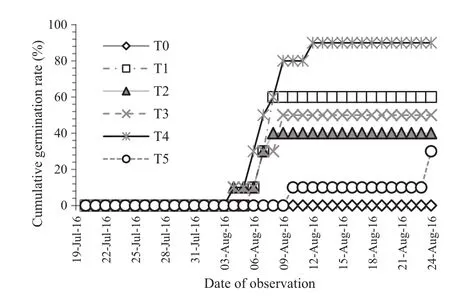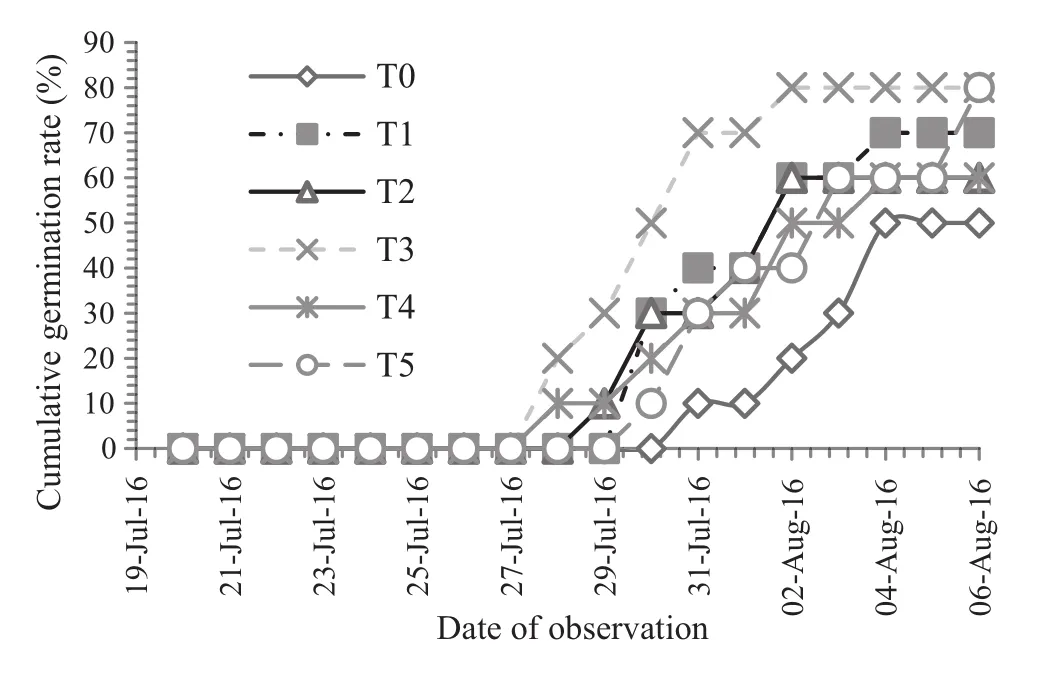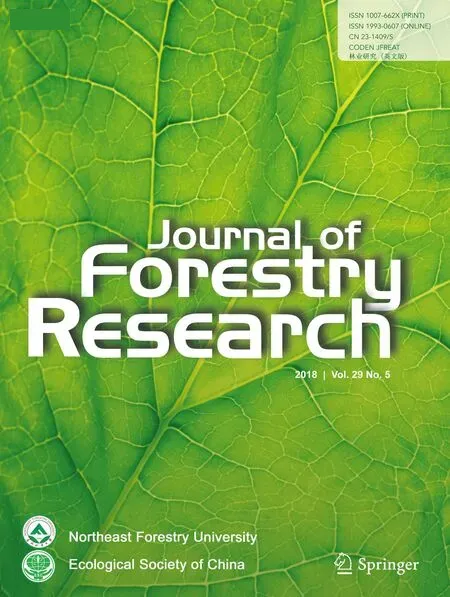Pre-sowing treatments for improved germination and growth of two rare native species of Bangladesh
M.A.Hossain•K.S.Islam•N.Rajasree•M.K.Hossain•M.S.Alam
Abstract Pre-sowing treatments are expected to increase seed germination.This evaluates response to pre-sowing treatments and the growth performance of two native and rare tree species,Garuga pinnata Roxb.and Vitex glabrata R.Br.The hard seed coats were treated by rubbing with sand paper,nail clipping,and immersion in water and acid(H2SO4).Results indicate that G.pinnata showed a 90%germination rate and 30%germination energy when seed coats were nicked with a nail clipper.Rubbing with sand paper was the best pre-sowing treatment for V.glabrata,resulting a 80%germination rate and 30%germination energy.G.pinnata and V.glabrata seedlings from seeds soaked 24 h in water resulted in maximum heights and collar diameters.These were significantly higher(at p<0.05)than those of other treatments.The results indicate that scarification or nicking of seeds may have some negative impacts on seedling growth.Therefore,it is difficult to recommend a pre-sowing treatment of seeds for achieving both maximum germination and good early seedling growth.
Keywords Germination ·Early seedling growth ·Height·Native species·Garuga pinnata·Vitex glabrata
Introduction
In contrast to introduced or exotic species,native plant species play important roles in forest ecosystems by maintaining ecological functions,providing food to wildlife and increasing resilience to climate change(Ahammad et al.2014).Bangladesh possesses a rich biological heritage of over 3610 species of flowering plants from different habitats.Unfortunately,446 have been rated as threatened due to habitat degradation,deforestation,agricultural expansion,and the planting of exotics along with other anthropogenic disturbances(Ahmed et al.2008a).Siddiqui et al.(2007)also reported that about 13%of vascular plants in Bangladesh (pteridophytes,gymnosperms and angiosperms)were under threat.The potential of forests to restore native tree species that are becoming rare is in doubt because of a drastic reduction of mother trees and soil seed banks,and the resultant shortage in seed supplies(Londe et al.2017;Armijos-González and Pérez-Ruiz 2016;Irfanullah 2011).Moreover,forest resources of Bangladesh,especially the hill forests and Sal forests,exhibit insufficient natural regeneration because of the depletion of resources due to anthropogenic interference,inappropriate methods of silviculture(i.e.,clearfelling followed by artificial regeneration),and a preference for exotic species over native for afforestation(Ahmed et al.2008b).Consequently,plant genetic diversity is being disrupted in an alarming way(Khan et al.2001;Hossain et al.2013).In some instances,although seeds germinate,survival is poor(Ahmed et al.2008a).If this situation continues,species under threat will become extinct in the near future.To restore the forests with native species,regeneration through nursery and plantation programs as well as development of seed orchards are essential. However, poor germination, delayed nursery establishment and slow growth limit the cultivation of threatened species in both forestry and homestead plantation programs.Good planning and appropriate nursery techniques could speed up germination rates and assure maximum quality seedlings from minimum seed sources.There is,however,little information on germination ecology of native threatened species,(Dayamba et al.2016),especially those of the hill forests.Although much research has been conducted on common plantation species,germination behavior and initial seedling growth of threatened native species has been largely ignored.Numerous studies,Alamgir and Hossain(2005),Asiedu et al.(2012),Hasnat et al.(2014),Hossain et al.(2005a,b,2011),Missanjo et al.(2014),Nath and Prasad(2000),Zare et al.(2011),have reported on the positive impacts of pre-sowing treatments on germination and initial growth performance of seedlings.Considering the importance of native and rare species to the ecological and environmental balance of the forest ecosystems,this research has been designed to assess the effects on seed germination by different pre-sowing treatments and the initial seedling growth attributes of Shilbhadi(Garuga pinnata)and Arsol(Vitex glabrata).These were once abundant but have been drastically depleted.
G.pinnataandV.glabrata,within the Burseraceae and Verbenaceae families respectively,were once common species in the forests of Chittagong,Chittagong Hill Tracts,Cox’s Bazar,Mymensingh and the Sylhet region of Bangladesh,but are now rare(Ahmed et al.2008a).G.pinnatais a medium-sized to large deciduous species with 2–5 cm thick bark,leaves 25–50 cm long,with 11–19 almost sessile leaflets,with 18 pairs of lateral veins, flowers greenish yellow,fruit a 1–5 seeded fleshy drupe(Das and Alam 2001).Flowering occurs from April to May,fruiting from June to August(Hossain 2015).Fruit collected for this study averaged 2.3 cm long×2.4 cm wide.This species coppices well and the branches are used for live-fences.The leaves are collected for fodder;fruits are acidic and eaten raw or in a curry(Das and Alam 2001).Leaves,fruit,stem bark and roots have medicinal uses and the wood for house frame,poles and furniture(Uddin 2014).Arsol(V.glabrata),a large deciduous species mainly occurs in the forests of Chittagong Hill Tracts(CHT),Chittagong,Sylhet,Dhaka and Mymensingh districts(Das and Alam 2001).Flowering occurs May–June,fruiting from July–August.Leaves have petioles 13 cm long, five elliptical oblong leaflets,with 9–14 lateral veins.The flowers are scented,white with a dash of blue;fruit a succulent drupe,black when ripe.Fruits collected for this study averaged 0.8 cm long×0.7 cm wide.
This research was carried out with the aim of discovering better and appropriate pre-sowing treatments for maximum germination,and growth performance in terms of shoot height and collar diameters of the germinated seedlings in the nursery.
Materials and methods
Seed collection and nursery experiment
Fruit and seeds ofG.pinnataandV.glabratawere collected in July from Hazarikhil natural forest.Healthy,disease-free seeds were sorted for different pre-sowing treatments in a completely random block design.Seed sorting was carried out during September 2014 to June 2015 in the Seed Research Laboratory;treatments and sowing were in the propagator house and in polybags at the nursery of the Institute of Forestry and Environmental Sciences,Chittagong University(IFESCU).
Application of treatments
The seeds ofG.pinnataandV.glabratawere dried in the sun for 3 days.Five treatments and one control with three replications each were(1)sowing the entire fruit(control;T0);(2)the seed untreated(T1);(3)seed soaked in water for 24 h(T2);(4)rubbing with sand paper at the distal end of the seed(T3);(5)nicking with a nail clipper at the distal end of the seed(T4);and,(6)seed soaking in 10%H2SO4for 5 min(T5).Schmidt(2000)reported that treatment of hard-coated seeds with chemicals like H2SO4increase germination capacity along with other parameters indicating germination behavior.
Preparation of the growth media for seedlings
Soil collected from the forest floor was dried,sieved(<3 mm)and mixed with decomposed cow dung in a ratio of 3:1 to fill 15 cm×10 cm polybags.The media used in the propagator house was fine Sylhet sand(river sand with Fineness Modulus of 2.5)and in the open nursery bed was top soil from the forest floor.
Germination and growth records
The experiments in polybags,propagator house and nursery beds with sown seeds were visited on a daily basis to observe the initiation of germination.The number of seeds germinated was counted and recorded with date at each alternate day since the start of germination to the last day of germination.The germinated seeds were allowed to grow in the nursery environment under regular watering.Morphological parameters of the seedlings,including shoot length and collar diameter of five vigorous seedlings from each treatment were recorded at 1 year of age.
Data analysis
The germination ofG.pinnataandV.glabrata,in terms of percentage(GP),value(GV),and energy(GE)were assessed following Kumar(1999),Djavanshir and Pourbeik(1976)and Aldhous(1972).The initial growth data were compiled in Excel for calculating GP,GV,and GE,and analyzed statistically by using Duncan’s Multiple Range Test(DMRT)in SPSS to determine morphological growth variations.The number of seeds germinated on successive days was used to calculate cumulative percentage and was shown as the progress and trends of germination.
Results and discussion
Germination behavior
Germination ofG.pinnatawas significantly affected by different pre-sowing treatments.Seeds nicked by nail clipper(T4)showed the highest germination percentage(90%),followed by 60%in T1(the whole seed sown untreated),50%in both T2(soaking in water for 24 h)and T3(sand paper rubbing).Germination percentage was lowest(30%)in seeds treated with sulphuric acid(T5)(Table 1).In case ofV.glabrata,germination response also varied by treatment.The maximum germination percentage(80%)and germination energy(30%)were with sand paper(T3).The whole seed sown treatment(T1)and soaking in H2SO4for 5 min(T5)resulted in 70%germination.Soaking in water for 24 h(T2)and nicking with a nail clipper(T2)gave 60%germination.
Germination depends on the potential of embryo growth or the potentials of germination and growth preventer(Koorneef and Hilhorst 2002).These potentials depend particularly on seed structure that surrounds the embryo,seed hormones and the environment(Mares2005).According to different research findings,scarification treatments with sand paper,nicking by nail clipper,using sulphuric acid as well as hot and cold water treatments have been effective for increasing germination rates by facilitating the entrance of moisture to the ovule and by helping the parts of the embryo that develop into primary root and rudimentary shoot to emerge from seeds with a hard seed coat(Hossain et al.2011).
In this study,pre-sowing treatments affected the germination rate,germination energy and germination period of bothV.glabrataandG.pinnata.Germination percentage ofG.pinnatawas increased by nail clipping(T4)up to 90 from 0%in sowing whole fruit(control).WithV.glabrata,the T3treatment(sand paper rubbing)increased germination percentage up to 80 from 50%in controls(sowing whole fruit).Other research has shown that scarification by sand paper increased the germination rate of Atlas cypress(Cedrus atlantica(Endl.)ManettiexCarriere)by up to 67%(Youssef et al.2012).Nath and Prasad(2000)reported sand paper rubbing to enhance the germination of Sesbania(SesbaniarostrataBremek.and Oberm.)seeds up to 77%.Alamgir and Hossain(2005)found the highest germination and seedling growth success in nail clipping followed by hot water treatment.However,Hossain et al.(2011)applied three pre-sowing treatments onFlacourtia jangomasseeds,i.e.,soaking in water for 24,48 and 72 h,and reported that germination started day 22 and ended day 66.The highest germination(82.7%)was with the seeds soaked in water for 48 h.The findings in this research also agree with Zare et al.(2011)who reported that scarification with sand paper was the most effective treatment in breaking seed dormancy and germination induction ofProsopis koelzianaandProsopis juli floraplants.However,Hossain et al.(2005a,b)reported germination 29 days after sowing depulped seed soaked in water for 48 h,compared to 41 days by control seeds.Asiedu et al.(2012)reported sulphuric acid at 90%concentration as the most effective pre-sowing treatment for the germination ofBauhinia rufescensLam.since its seeds produced the highest germination capacity(93.8%)and germination energy at 7,10 and 12 days after sowing.Suchdifferences in effectiveness of pre-sowing treatments may be due to differences in temperatures,the extent of scarification,the concentration of chemicals,and variations in seed coat thickness(Azad et al.2011).

Table 1 Germination percentage,energy,and period of G.pinnata and V.glabrata seeds
Trends of germination
Germination ofG.pinnatastarted earlier on day 16 with T2(soaking in water for 24 h),T3(sand paper rubbing at the distal end),and T4(nail clipping at distal end)treatments,whereas germination started on day 18 in the case of T1(the whole seed sown)and on the 22nd day with T5(Fig.1).WithV.glabrata,seeds started germinating on the 9th day after sowing)treated by sand paper rubbing(T3)and nail clipping(T4)(Fig.2).Immediately after the T3and T4germination started,germination began on the 10th day in T2treatment followed by treatments T1and T5(11th day),and T0(12th day).

Fig.1 Mean cumulative germination percentage(%)of G.pinnata in different pre-sowing treatments(T0is whole fruit sown,T1is whole seed sown,T2is soaked in water for 24 h,T3is sand paper rubbing,T4is nail clipping of seed coat,T5is soaked in H2SO4for 5 min)

Fig.2 Mean cumulative germination percentage(%)of V.glabrata in different pre-sowing treatments(T0is whole fruit sown,T1is whole seed sown,T2is soaked in water for 24 h,T3is sand paper rubbing,T4is nail clipping of seed coat,T5is soaked in H2SO4for 5 min)
High germination capacity is indicative of high vigor and high field emergence compared with a low capacity seen in delayed germination.Treatments resulting in lower germination produce seeds with lower competitive abilities than early emerging ones(Pourhadian and Khajehpour 2010).Based on mechanical scarification resulting in increment of germination percentage and rate,dormancy of these seeds is exogenous or results from external factors.If factors like water and oxygen do not enter the seed to initiate imbibition,exogenous dormancy occurs and results in decreasing germination(Bewley 1997).Moreover,the existence of specific substances in seed coats may also hinder imbibition.Since little response was observed in the control,T1(whole seed untreated),T2(immersion in water 24 h at room temperature)and T5(soaking in H2SO4for 5 min),hard-coated seeds ofV.glabrataandG.pinnatarequire pre-sowing treatment(sand paper rubbing,nail clipping)for better germination.
Initial growth of G.pinnata and V.glabrata in the nursery
Growth of seedlings in height and collar diameter was recorded up to 12 months.The data show that height ofV.glabratawas maximized(107.0±3.8)cm in the water treatment(T2),followed by T4nail clipping(88.0±6.6)cm,T1whole seed(75.7±21.7)cm,T3(61.7±7.4)cm in sand paper rubbing.Height growth was lowest(53.3±13.9 cm)in the control(T0)(Table 2).Collar diameter growth was also maximized with seedlings developed from seeds soaked in water(T2)(1.7±0.1 cm)followed by T4(1.6±0.1 cm)in the nail clipping treatment and T5(1.2±0.7)cm in H2SO4for 5 min.The ANOVA test with DMRTposthoctest indicated that no treatment gave significantly different growth performance ofV.glabratain height or diameter.
G.pinnatashoot growth was maximized(166.0±20.6)cm from seeds treated by soaking in water for 24 h followed by T1(160.7±20.6)cm and T4(144.3±11.1)cm.Collar diameter growth was maximized(2.9±0.2)cm in T2followed by T1(2.17±0.93)cm,T4(1.5±0.4)cm and T3(1.0±0.3)cm.No germination took place in the control.ANOVA with DMRTposthoctesting indicated that the treatments,i.e.,soaking of seeds in water for 24 h,sowing whole seeds without scarification and nail clipping at distal end of seeds,had significant positive influence on shoot heights and collar diameter growth ofG.pinnataseedlings.
Pre-sowing treatments affecting the initial growth of seedlings at the nursery stage is different than on germination behavior.Seedlings of bothG.pinnataandV.glabratafrom seeds immersed in water for 24 h produced significantly(p<0.05)higher shoot heights and collar diameters than seedlings from seeds nicked by nail clipper and by sand paper rubbing.Nicking by nail clipper and sand paper rubbing,the two effective treatments for germination,may have a scratching effect on ovule growth but water treatment for 24 h has less possibility of this occurring.As a result,the best initial growth is not obtained from seeds treated by nicking by nail clipper or by sand paper rubbing.However,growth of the seedlings found from seeds treated by sand paper rubbing and nicking by nail clipper is satisfactory as other similar studies.Alamgir and Hossain(2005)and Missanjo et al.(2014)reported comparable height and collar diameter growth at 1 year of age.

Table 2 Influence of five different treatments on height and collar growth of 1-year-old V.glabrata and G.pinnata seedlings
Conclusion
The results confirm earlier observations that germination capacity and other germination assessment parameters improve with pre-sowing treatment.From this study,it can be said that nail clipping has substantially positive impact on germination rate and germination energy of bothG.pinnataandV.glabrata.Germination speed ofG.pinnatawas greatest for nail clipping whereas sand paper rubbing imparted maximum germination rate ofV.pinnata.Therefore,seed scarification by nail clipping and sand paper rubbing may be suggested as pre-sowing treatment forG.pinnataandV.glabratarespectively in order to get better germination.However,soaking seeds in water for 24 h resulted in seedlings of both species with the best initial growth.
AcknowledgementsThe authors acknowledge the support of Arannayk Foundation(Tropical Forest Conservation Foundation)as well as the Institute of Forestry and Environmental Sciences,Chittagong University during this research.
 Journal of Forestry Research2018年5期
Journal of Forestry Research2018年5期
- Journal of Forestry Research的其它文章
- Environmental load of solid wood floor production from larch grown at different planting densities based on a life cycle assessment
- Variability in physical properties of plantation-grown progenies of Melia composita and determination of a kiln-drying schedule
- Optimization of CNC cutting parameters using design of experiment(DOE)and desirability function
- Reduction of electric field strength by two species of trees under power transmission lines
- Forest type identification by random forest classification combined with SPOT and multitemporal SAR data
- Forest mapping:a comparison between hyperspectral and multispectral images and technologies
